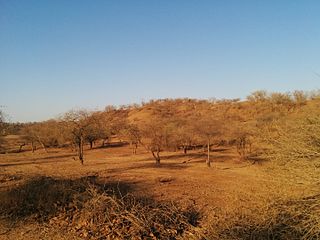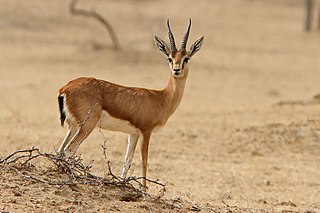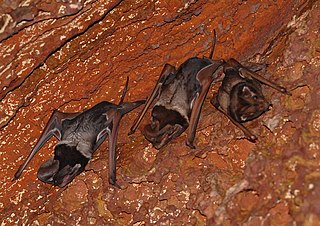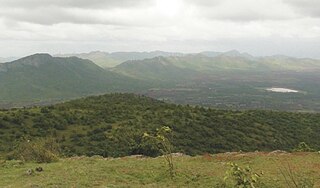Related Research Articles

Bannerghatta National Park is a national park in India, located near Bangalore, Karnataka. It was founded in 1970 and declared as a national park in 1974. In 2002, a small portion of the park became a zoological garden, the Bannerghatta Biological Park.

The Khathiar–Gir dry deciduous forests is a mostly arid ecoregion in northwestern India that stretches over 103,100 sq mi (267,000 km2) across Gujarat, Rajasthan and Madhya Pradesh. The dry deciduous forests in the region are dominated by teak, and thorny trees and scrub in drier areas.

The chinkara, also known as the Indian gazelle, is a gazelle species native to India, Iran, Afghanistan And Pakistan.

Wayanad Wildlife Sanctuary is a wildlife sanctuary in Wayanad, Kerala, India with an extent of 344.44 km2 (132.99 sq mi) and four hill ranges namely Sulthan Bathery, Muthanga, Kurichiat and Tholpetty. A variety of large wild animals such as gaur, Indian elephant, deer and Bengal tiger are found there. There are also quite a few unusual birds in the sanctuary. In particular, Indian peafowl tend to be very common in the area. Wayanad Wildlife Sanctuary is the second largest wildlife sanctuary in Kerala. It is bestowed with lush green forests and rich wildlife. This wildlife area houses some of the rare and endangered species of both flora and fauna.
Rajaji National Park is an Indian national park and tiger reserve in the Indian state of Uttarakhand. that encompasses the Shivaliks, near the foothills of the Himalayas. It covers 820 km2 (320 sq mi) and includes three districts of Uttarakhand: Haridwar, Dehradun and Pauri Garhwal. In 1983, three wildlife sanctuaries in the area namely, Chilla, Motichur and Rajaji were merged into one.
Tamor Pingla Wildlife Sanctuary is located in Surajpur District, Chhattisgarh, India. It is named after the Tamor Hill and Pingla Nalla, the old and prominent features of the area. In 2021, National Tiger Conservation Authority has approved the Chhattisgarh government's proposal to declare the combined areas of the Guru Ghasidas National Park and Tamor Pingla Wildlife Sanctuary as a Tiger Reserve.

Bhadra Wildlife Sanctuary is a protected area and tiger reserve as part of the Project Tiger, situated in Chikkamagaluru district, 23 km (14 mi) south of Bhadravathi city, 38 km (24 mi) 20 km from Tarikere town, northwest of Chikkamagaluru and 283 km from Bengaluru city in Karnataka state, India. Bhadra sanctuary has a wide range of flora and fauna and is a popular place for day outings. The 1,875 m (6,152 ft) above MSL Hebbe Giri is the highest peak in the sanctuary.

The state of Karnataka in South India has a rich diversity of flora and fauna. It has a recorded forest area of 38,720 km2 which constitutes 55
of the geographical area of the state. These forests support 25% of the elephant population and 20% of the tiger population of India. Many regions of Karnataka are still unexplored and new species of flora and fauna are still found. The mountains of the Western Ghats in the western region of Karnataka are a biodiversity hotspot. Two sub-clusters of the Western Ghats, Talacauvery and Kudremukh, are on a tentative list of sites that could be designated as World Heritage Sites by UNESCO. The Bandipur and Nagarahole national parks which fall outside these subclusters were included in the Nilgiri biosphere reserve in 1986, a UNESCO designation. In the Biligiriranga Hills the Eastern Ghats meet the Western Ghats. The state bird and state animal of Karnataka are Indian roller and the Indian elephant. The state tree and state flower are sandalwood and lotus. Karnataka is home to 524 tigers.

Dandeli Wildlife Sanctuary is located at 15°30′23″N74°23′30″E in Uttara Kannada District of Karnataka state in India. The sanctuary covers an area of 866.41 km2 (334.52 sq mi).

Bhimgad Wildlife Sanctuary is a protected area in the Western Ghats, in Khanapur Taluk of Belgavi District near Jamboti Village, Karnataka state, India. This 19,042.58 ha (73.5238 sq mi) of Tropical and subtropical moist broadleaf forests forest area was long awaiting to be a wild life sanctuary and finally declared in December 2011.

Asola-Bhati Wildlife Sanctuary covering 32.71 km2 area on the Southern Delhi Ridge of Aravalli hill range on Delhi-Haryana border lies in Southern Delhi as well as northern parts of Faridabad and Gurugram districts of Haryana state. Biodiversity significance of Ridge lies in its merger with Indo-Gangetic plains, as it is the part of the Northern Aravalli leopard wildlife corridor, an important wildlife corridor which starts from the Sariska National Park in Rajasthan, passes through Nuh, Faridabad and Gurugram districts of Haryana and ends at Delhi Ridge.

Daroji Sloth Bear Sanctuary is located in Ballari district in Karnataka. This is Asia's first sloth bear sanctuary. It is spread over 82.72 km2 (31.94 sq mi). The sanctuary was created exclusively for the conservation of the sloth bear. It is about 50 km from Ballari and about 15 km from the World Heritage Site Hampi. The area between Daroji in Sandur taluka and Ramasagar of Hospet Taluk is host to numerous sloth bears.

Jogimatti is a hill station and forest reserve in Chitradurga district, Karnataka, India. The reserve covers 10,048.97 hectares (38.7993 sq mi) in Chitradurga, Holalkere and Hiriyur taluks, 10 kilometres (6.2 mi) south of the city of Chitradurga. There is a century-old hilltop bungalow built by the British to house travellers, and a nearby temple dedicated to the local saint for whom the hill station was named, with 155 steps. The reserve has a small zoo called Adumalleshwar, which the Central Zoo Authority of India ordered renovated in 2012 to better house the animals, and an ecotourism adventure centre which opened in 2010. A waterfall called Himavatkedara or Himavatkedra has created a natural cave in which a Shiva lingam and idols of Veerabhadra and Basavanna have been placed.
Forests Department, Haryana is a department of the Government of Haryana in India that runs and maintains many protected nature areas in the state of Haryana. It has two administrative divisions: Forest and Wildlife. The department is responsible for maintaining National Parks, Wildlife Sanctuaries and Conservation Reserves in Haryana. It also provides a special emphasis on Soil and Moisture Conservation works in the hills to conserve water and deliver it to adjacent farmlands. Two National Parks, eight Wildlife Sanctuaries, two Conservation Reserves, four Animal & Bird Breeding Centres, one Deer park, and 49 herbal parks. Kanwar Pal Gujjar has been the cabinet minister responsible for this department since October 2019. constitute the Protected Area network of the department, covering 0.75% of the state. It also maintains a list of Protected Areas in Haryana.

Mookambika Wildlife Sanctuary is a protected wildlife sanctuary in the southern state of Karnataka in India. It derives its name from the presiding deity "Goddess Mookambika" of the popular Kollur Mookambika Temple. The sanctuary lies in the Western Ghats in Udupi district of Karnataka. The sanctuary consists of an area of 274 km2 (106 sq mi) was notified in the year 1974, by the Government of Karnataka vide notification AFD.48.FWL.74 dated 17 June 1974.
Gudekote Sloth Bear Sanctuary is located in Ballari district in Karnataka, India. It is spread over 38.48 km2 (14.86 sq mi). The sanctuary was created exclusively for the preservation of the Indian sloth bear and is Asia's second sloth bear sanctuary, the first being Daroji Sloth Bear Sanctuary.
Sanjay Gubbi is a conservation biologist based in Karnataka, India. His work focuses on the conservation of large carnivores like tigers and leopards, working on applied aspects and understanding their population biology, proposing conservation policies for their protection, and working to minimize human-wildlife conflict. He currently works as a scientist with Nature Conservation Foundation, a Mysore based NGO.
Koderma Wildlife Sactuary is located in the northern part of Koderma in the Koderma subdivision of the Koderma district in the state of Jharkhand, India.
Nugu Wildlife Sanctuary is situated north of Bandipur National Park in Mysore District of Karnataka, India. The northern part of Nugu WLS is occupied by the Nugu Reservoir. It serves as a home to many species of flora and fauna such as Dipterocarpus indicus, Calophyllum tomentosum, elephants, wild pigs, spotted deer, leopards, jungle cats, etc. This wildlife sanctuary serves as a great tourist attraction, especially in the months of October to April.
Thimlapura Wildlife Sanctuary is located in the Madhugiri and Koratagere Taluk of Tumkur in the state of Karnataka. It was declared a wildlife sanctuary under Section 36-A of the Wild Life (Protection) Act, 1972. It is inhabited by leopards, sloth bears, wild boars, Indian foxes, wolves, among other animals. Thimlapura Wildlife Sanctuary is a conservation reserve for sloth bear.
References
- ↑ "Jogimatti will be a Wildlife Sanctuary". The New Indian Express. Retrieved 2023-12-20.
- 1 2 3 "Jogimatti declared sanctuary". The Hindu. 2016-01-13. ISSN 0971-751X . Retrieved 2023-12-20.
- 1 2 3 Kaggere, Niranjan (May 26, 2016). "Exclusive sanctuary for chinkaras soon". Bangalore Mirror. Retrieved 2023-12-20.
- 1 2 "At Jogimatti, mining ban remains on paper as depts not on same page". Deccan Herald. Retrieved 2023-12-20.